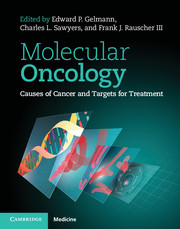Book contents
- Frontmatter
- Dedication
- Contents
- List of Contributors
- Preface
- Part 1.1 Analytical techniques: analysis of DNA
- Part 1.2 Analytical techniques: analysis of RNA
- Part 2.1 Molecular pathways underlying carcinogenesis: signal transduction
- Part 2.2 Molecular pathways underlying carcinogenesis: apoptosis
- Part 2.3 Molecular pathways underlying carcinogenesis: nuclear receptors
- Part 2.4 Molecular pathways underlying carcinogenesis: DNA repair
- Part 2.5 Molecular pathways underlying carcinogenesis: cell cycle
- Part 2.6 Molecular pathways underlying carcinogenesis: other pathways
- Part 3.1 Molecular pathology: carcinomas
- Part 3.2 Molecular pathology: cancers of the nervous system
- Part 3.3 Molecular pathology: cancers of the skin
- Part 3.4 Molecular pathology: endocrine cancers
- Part 3.5 Molecular pathology: adult sarcomas
- Part 3.6 Molecular pathology: lymphoma and leukemia
- Part 3.7 Molecular pathology: pediatric solid tumors
- Part 4 Pharmacologic targeting of oncogenic pathways
- 78 Oncology drug discovery for biologics: antibody development strategies and considerations
- 79 Targeting the EGFR family of receptor tyrosine kinases
- 80 Therapeutic approaches with antibodies to cell-surface receptors
- 81 Signal transduction in tumor angiogenesis
- 82 Tyrosine-kinase inhibitors in oncology
- 83 Anti-estrogens and selective estrogen-receptor modulators
- 84 Therapeutic applications of anti-sense mechanisms for the treatment of cancer
- 85 Induction of apoptosis
- 86 DNA-methylation inhibitors
- 87 Histone deacetylase inhibitors
- 88 Drug resistance: as complex and diverse as the disease itself
- 89 Molecular profiling and therapeutic decision-making: the promise of personalized medicine
- 90 DNA repair inhibition in anti-cancer therapeutics
- Index
- References
80 - Therapeutic approaches with antibodies to cell-surface receptors
from Part 4 - Pharmacologic targeting of oncogenic pathways
Published online by Cambridge University Press: 05 February 2015
- Frontmatter
- Dedication
- Contents
- List of Contributors
- Preface
- Part 1.1 Analytical techniques: analysis of DNA
- Part 1.2 Analytical techniques: analysis of RNA
- Part 2.1 Molecular pathways underlying carcinogenesis: signal transduction
- Part 2.2 Molecular pathways underlying carcinogenesis: apoptosis
- Part 2.3 Molecular pathways underlying carcinogenesis: nuclear receptors
- Part 2.4 Molecular pathways underlying carcinogenesis: DNA repair
- Part 2.5 Molecular pathways underlying carcinogenesis: cell cycle
- Part 2.6 Molecular pathways underlying carcinogenesis: other pathways
- Part 3.1 Molecular pathology: carcinomas
- Part 3.2 Molecular pathology: cancers of the nervous system
- Part 3.3 Molecular pathology: cancers of the skin
- Part 3.4 Molecular pathology: endocrine cancers
- Part 3.5 Molecular pathology: adult sarcomas
- Part 3.6 Molecular pathology: lymphoma and leukemia
- Part 3.7 Molecular pathology: pediatric solid tumors
- Part 4 Pharmacologic targeting of oncogenic pathways
- 78 Oncology drug discovery for biologics: antibody development strategies and considerations
- 79 Targeting the EGFR family of receptor tyrosine kinases
- 80 Therapeutic approaches with antibodies to cell-surface receptors
- 81 Signal transduction in tumor angiogenesis
- 82 Tyrosine-kinase inhibitors in oncology
- 83 Anti-estrogens and selective estrogen-receptor modulators
- 84 Therapeutic applications of anti-sense mechanisms for the treatment of cancer
- 85 Induction of apoptosis
- 86 DNA-methylation inhibitors
- 87 Histone deacetylase inhibitors
- 88 Drug resistance: as complex and diverse as the disease itself
- 89 Molecular profiling and therapeutic decision-making: the promise of personalized medicine
- 90 DNA repair inhibition in anti-cancer therapeutics
- Index
- References
Summary
The development of hybridomas and the treatment of a non-Hodgkin lymphoma patient with antibody AB89 are commonly heralded as the landmarks of the monoclonal antibody therapy field (1,2). After three decades, over 600 of these agents have entered clinical development (3); however, only a few are currently approved for the treatment of cancer patients. Novel technologies, including phage display, recombinant-antibody engineering, and transgenic-animal generation, allow for the production of highly potent, fully human antibodies or antibody constructs that may facilitate the development of more effective and less toxic monoclonal antibody therapies.
On a structural basis, monoclonal antibodies can be classified into “naked” antibodies that relay direct effects on target antigens and immunoconjugates. Naked antibodies can be employed for serum clearance of growth factors, and the activation or blockade of cell-surface receptors. These effects are mediated by the antibody Fab (fragment antibody binding) portion, which contains the hypervariable complementarity-determining regions of the light and heavy chains that constitute the antigen binding site (Figure 80.1), while the Fc portion mediates immunological effects. Fc (fragment crystallizable) binding and activation of FcγRs on effector cells transduce activating or inhibitory signals. Fc-dependent stimulatory signals are mainly transduced by FcγRI, FcγRIIa, and FcγRIIIa, whereas FcγRIIb is inhibitory. Natural killer cells express almost exclusively FcγRIIIa that is responsible for mediating ADCC by these cells, whereas macrophages express FcγRI, FcγRIIa, and FcγRIIIa, with FcγRIIa being the key receptor responsible for the induction of phagocytosis (4). Variations in antibody isotype backbone determine their ability to bind FcγRs and to induce antibody-dependent cell-mediated cytotoxicity (ADCC) and phagocytosis (ADCP). Naturally occurring human IgG2 antibodies weakly bind FcγRIIa and constitute ideal molecules when specific target inhibition or activation, without immunologically mediated effects, is the desired attribute (5). In contrast, murine IgG2a, and human IgG1 and IgG3 antibodies bind all activatory FcγRs and are effective inducers of ADCC and ADCP. IgG3 and IgM molecules are also strong inducers of complement fixation through the classical C1q pathway, driving complement-dependent cytotoxicity (CDC). The IgG3 backbone, however, is not commonly used in therapeutic antibody development due to the short half-life (>7 days) of these molecules. Also, the large size of IgM pentamers, the functional IgM unit, limits its ability to reach the interstitial compartment, and IgM monoclonals are rarely employed in therapeutic antibody development.
- Type
- Chapter
- Information
- Molecular OncologyCauses of Cancer and Targets for Treatment, pp. 854 - 860Publisher: Cambridge University PressPrint publication year: 2013

